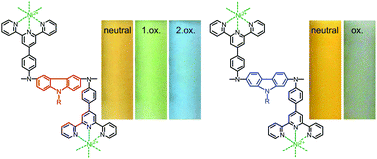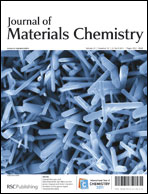Supramolecular assembly of electrochromic films of terpyridine-functionalized polyiminocarbazolylene metal complexes
Abstract
Preparation, metal ion complexation and coordinative assembly of polyiminocarbazolylenes with terpyridine substituent groups into organized electrochromic films are described. Polymers P-2,7 and P-3,6 were prepared upon Pd-catalyzed coupling of 2,7-dibromo-N-(2-ethylhexyl)carbazole or 3,6-dibromo-N-(2-ethylhexyl)carbazole and 4′-(4-aminophenyl)-2,2′:6,2″-terpyridine. Molecular weights of about 3 000 Da were obtained indicating the formation of oligomers. The compounds are soluble in common organic solvents. P-3,6 exhibits blue, green or yellow fluorescence in toluene, tetrahydrofuran (THF), or dichloromethane, respectively, whereas P-2,7 exhibits a blue fluorescence independent from the polarity of the solvent. Fluorescence quantum yields up to 68% were found. Upon addition of divalent metal salts such as zinc, nickel or cobalt acetate, colour transitions involving isosbestic points occur. Titration experiments indicate the formation of 2 : 1 and 1 : 1 tpy : metal ion complexes. Organized films of the polymer–metal ion complexes can be prepared, if pretreated negatively charged substrates (quartz, ITO-coated glass) are sequentially dipped into a THF/DMF/n-hexane (1 : 0.1 : 1, v/v) solution of the metal hexafluorophosphates and the THF/n-hexane (1 : 1, v/v) solutions of the polymers. Films of the zinc and nickel ion complexes of P-3,6 and P-2,7 are yellow in the neutral state, whereas films containing the cobalt complex are pink. Upon anodic oxidation, all films exhibit electrochromic properties. Films containing P-3,6 exhibit color changes into green and blue (zinc and nickel) or greenish brown (cobalt). For films containing P-2,7 the oxidation potentials are generally higher. Upon oxidation, color changes into grey (zinc), olive (nickel), or brown (cobalt) are found. All color changes are reversible, even under ambient conditions. Switching times of the films prepared upon twelve dipping cycles are between 300 ms and 1.1 s, the change of transmittance being low (2.8 to 4%) at 800 nm, but rather high at 300 nm (up to 24.6%). The self-assembled films are useful for preparation of electrochromic devices.


 Please wait while we load your content...
Please wait while we load your content...